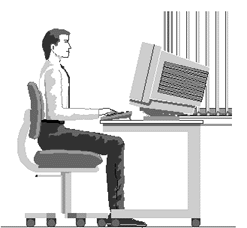Health and Comfort Guide (Rev 1.10.1)
Introduction
The purpose of this guide is to help work habits that will minimise your
likelihood of developing work-related injuries such as carpal tunnel syndrome, eyestrain
and repetitive strain injury. These syndromes can develop if ergonomic considerations are
not taken into account when planning your work environment and using computer equipment.
It is important that you develop work habits which do not place undue strain on your body,
and that you learn to use your computer equipment in a safe and comfortable manner.
Equipment and Environment
This section contains suggestions for arranging your personal work space
in a way that not only minimises potential hazards, but can also contribute to your
productivity and comfort while working.
Work Space
It is important that your work space be arranged in a way which allows
for ease of movement. Your desk level should be high enough to allow adequate clearance
for your legs and chair, and your work area spacious enough to allow you to reach
equipment without twisting or straining. Arrange items on your desk according to frequency
of use, and position your keyboard and mouse so that you don't have to stretch or reach
around other items to use them.
Keep your work area free from distractions such as noise, extremes in
temperature, and glare from lights or windows. You may find it necessary to rearrange your
work space to cut down on distractions.
Chair
Choose a chair which is height-adjustable so that you are positioned at
a comfortable level to your work surface. Adjust your chair height so that your elbows
bend at approximate right angles when you place your hands on your work surface. Your feet
should be placed flat on the floor and your knees should be at an even level with your
hips. Use a footrest if your chair is too high for you to place your feet flat on the
floor.
Your chair should also have an adjustable back to provide you with firm
lumbar support and encourage you to sit upright. Do not slouch while working, as this will
put unnecessary strain on your muscles. If your chair has armrests, they should be
adjusted to a height which allows you to rest your elbows and forearms on them without
slouching at the shoulders.
Keyboard
Place your keyboard directly in front of you when you are typing, to
minimise reaching and twisting. Use a light touch when hitting keys and keep your wrists
straight. Do not allow your wrists to rest on the hard edge of the desk. If you find you
have difficulty maintaining a proper wrist position, use a wrist-leveller. Take frequent
breaks while typing to give your muscles a chance to relax.
Mouse
Position your mouse pad close to your keyboard so that you can easily
move the mouse without having to extend your arm awkwardly. Rest your hand lightly on the
mouse and do not use unnecessary force when clicking on the mouse button. Clean your mouse
regularly so it moves smoothly and with a minimum degree of effort on your part.
Monitor
Position your monitor directly in front of you at a comfortable distance
for viewing (generally 50 to 60cm from your eyes). Adjust the angle of the monitor so that
the top of the display is approximately level with your line of vision. Your display image
should be stable and flicker-free, and distracting glare or reflections from windows and
lights should be eliminated. If necessary, rearrange your work space to keep your display
screen glare-free.
If you must use your monitor for long periods of time, take at least one
5-10 minute break hourly to allow your eyes to rest. Have regular eye examinations, and
visit your doctor if you experience any discomfort or difficulty with your vision. All EC
countries now require employers to provide employees who use computer monitors on the job
with regular eye examinations free of charge.

Work Habits
Adopting good work habits can help you to remain comfortable and healthy
while using your workstation, and can also improve your productivity. Take frequent rest
breaks during long periods of strenuous typing and vary your tasks if possible, so that
your body does not have to repeat the same motions for long periods of time.
Simple stretching exercises can help relax your muscles and improve
circulation. Ask your doctor or company safety officer to recommend some exercises that
you can do at your desk or during rest breaks.
Refer to the following checklist to see how you can improve your work
habits:
· take frequent rest breaks
· limit typing speed
· vary tasks
· exercise
· employ relaxation techniques
· maintain good posture
· keep feet flat on floor while typing
· minimise twisting and reaching movements
· minimise repetitive movements
· position your keyboard, monitor and mouse as recommended
· ensure that your chair and desk are at comfortable heights
· eliminate glare from lights or windows
Prevention
Don't overlook the importance of a healthy lifestyle in the prevention
of illnesses. Exercise, proper rest, a healthy diet, and regular doctor's appointments
will help you to remain in good health. If you experience persistent discomfort, see your
doctor.
Eye Care
Have your eyes checked regularly. Many eye care professionals now offer
specially-treated lenses which may help reduce screen glare and eyestrain.
If you feel your eyes tiring during long periods in front of your
monitor, look away from the display for a few moments and focus on an abject across the
room. This will help to reduce eye strain and combat fatigue.
 

|

